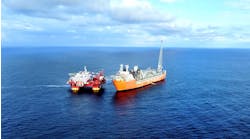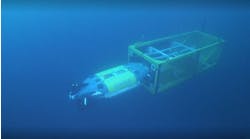Offshore staff
FARNBOROUGH, UK – Blue Ocean Seismic Services has completed sea trials of its underwater autonomous vehicle in the North Sea, using a DP-2 multi-role vessel.
During testing at various weights, the vehicle consistently coupled to the seabed to acquire ocean bottom seismic (OBS) data for offshore exploration and other applications such as carbon capture and offshore wind farm development.
Blue Ocean claimed the collected data was comparable to existing ocean bottom node (OBN) technology.
The development is supported by bp Ventures, Woodside Energy and Blue Ocean Monitoring, as a potentially lower-cost, faster, safer, and less carbon-intensive approach to OBS acquisition.
Following further work, Blue Ocean plans to stage further seismic trials at multiple locations, followed by pre-commercial sea tests from H1 2022 onwards.
According to the company, marine seismic data acquisition remains largely dependent on use of streamer cables deployed from the aft of a diesel-powered vessel and towed on a previously designated track line, traveling at 2 to 5 knots.
However, this arrangement may not suit certain locations and environments. ROV-positioned OBNs are also said to be high-cost.
Blue Ocean claims use of its vehicles could cut seismic survey costs by more than 50%, also dispensing with the need for energy-intensive exploration vessels.
The systems are powered by rechargeable batteries, so the nodes can remain submerged for almost three months, transferring to different locations underwater before recharging and redeployments.
10/12/2021



